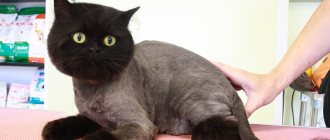How does it arise
To understand whether there is an allergy to British cats, it is enough to realize the following fact: fur has nothing to do with the development of a negative reaction - it’s all about the protein that the cat’s sebaceous glands produce.
The protein is found in the saliva, urine and skin cells of cats. The main route of allergen transmission is animal dander, that is, dead particles of the epidermis. They are practically invisible to the naked eye, but spread throughout the entire room in which the cat lives. A person inhales dandruff, it gets on mucous membranes, such as the eyes and nose, and enters the bloodstream through skin lesions.
This is not harmful for a healthy person - we constantly inhale a wide variety of substances that do not have any effect on the course of internal processes. However, the immune system of allergy sufferers perceives cat protein as a harmful particle. The body tries with all its might to get rid of the allergen, which causes defensive reactions (runny nose, cough, lacrimation, etc.).
Important! Allergies do not always occur specifically to animals. Sometimes the cause is chemical additives in the food, low-quality filler, or particles that the cat brings home from the street after free-walking.
In addition to the dander that gets on the fur, protein is found in the animal's saliva. Even if you don't allow your cat to lick you, the protein can be absorbed through the bloodstream. Most often it happens like this: the animal licks its paws, then you decide to play with it, and, carried away, the pet scratches you. Particles of saliva, and with them the allergen, enter the bloodstream.
Another route of transmission of cat protein is through the litter box. If an allergic person independently changes the litter in an animal’s toilet, he inevitably inhales protein particles. Approaching the cat's litter box constantly results in tears, coughing, runny nose or itching.
What reduces the concentration of allergens?
The first is hygiene.
Your pet needs to be bathed once a week, using special shampoos that reduce or block the effect of irritants. There are the same wipes - ideal for caring for naked breed cats. Be sure to brush your cat daily, removing loose hairs with a rubber glove or a damp hand. You should not allow your paws to become contaminated with urine - urine contains a very high concentration of allergens, which the cat will certainly spread throughout the apartment. Therefore, you need to use high-quality litter and clean the tray daily.
For allergy sufferers, and especially for children, all these procedures can be dangerous. Therefore, another family member must take care of the cat. Decide in advance whether someone is willing to take on these responsibilities (regularly, over many years!).
What could be better than a small fluffy kitten lying purring next to you? Or on you, which they really love. Being in close proximity with this bundle of joy brings a lot of pleasure, but for many it also brings a lot of trouble. For example, an allergy to wool.
Most often, people suffering from this type of disease find out about it when they have already taken a small kitten into their home. Soon you will have to not only look for a new home for your beloved pet, but also treat the consequences of allergies. I wonder if such situations can be prevented? This is what we will look into today. First you need to find out about the causes of allergies to the fur of British cats.
Causes of allergies to cat fur
This type of allergy does not depend on the person’s age. So symptoms can appear in both a child and an adult. If a person has any other form of allergy, for example to dust or pollen from a plant, then he is at risk. Allergy research has shown that this disease is hereditary, that is, it can be passed on from generation to generation.
About 15% of the world's population suffers from allergies caused by pet dander. It is true that it is not the wool itself that causes discomfort and disease, but the substances contained on it. This could be animal saliva or skin particles. Saliva contains protein, which, when licked, gets onto the fur.
It is this substance that triggers allergies. Can protein really cause such violent reactions in the human body?
This is where the immunity that a person has is important. If he is susceptible to other allergies, it means that the immune system is very sensitive and cannot fight the protein. When the cells of this substance enter the body of an allergic person, a protective reaction begins. This is indicated by certain symptoms.
Symptoms of an allergy to cat fur
It is very difficult not to notice the symptoms that occur with a wool allergy, as they cause a lot of unpleasant sensations.
These include:
- runny or stuffy nose,
- burning and tearing of the eyes,
- cough and asthma attacks,
- as well as a rash on the body.
Such manifestations should alert every cat owner. But not many people pay attention to this. Perhaps because of their negligence, or maybe because they do not want to admit it, so as not to say goodbye to their pet. Only away from the animal does a person feel a relief of symptoms, and when the cat approaches, their occurrence occurs. After this, there is no doubt that the person is allergic to wool.
Unfortunately, it is impossible to get rid of such allergies. The only thing that can be done is to reduce the risk of its development. This is done at an early age. The immune system of a child with a susceptibility to allergies, upon contact with a cat, develops a protective reaction. These procedures help to avoid allergies in adulthood.
Treatment methods for allergies to cat fur
There are several methods that are used to treat wool allergies. They consist of the use of standard anti-allergy medications:
- Antihistamines. They relieve symptoms by blocking the chemicals that cause them. For example, Astelin, Alegra and Zirtek spray, but they are available only with a prescription. There are also Claritin and Benadryl, which can be purchased without a prescription.
- Decongestants. They help relieve or reduce swelling and relieve mucus stagnation. These include Allgra-D, which is sold only by prescription, and Sudafed, which is sold without a prescription.
- Other medications designed to prevent or relieve symptoms caused by cat dander allergies. For example, Flonase and Nasonex are standard steroids used in the treatment of allergies.
Rules of conduct for allergies to cat fur
There are several rules that need to be combined with drug treatment. They help reduce the risk of wool allergies. These rules include:
- Pet hygiene;
- Prohibit cats from lying in places where people with allergies sleep or rest. You can also use special bedding;
- Carry out wet cleaning in the house or premises where there is a cat and a person;
- Proper nutrition for your cat, which will help get rid of excessive hair loss;
- Maintain personal hygiene rules, especially after contact with animals.
In a short period of time, the cat becomes a full member of the family. And a disease such as wool allergy brings great discomfort to people’s lives. Getting rid of your beloved furry friend is not an option, but an extreme option. After all, there are many ways and methods that will allow you not to give up on your four-legged family member, without harming either him or yourself.
What could be more beautiful than a fluffy ball that will lie next to you and purr sweetly? This is a real blessing for cat lovers. But people prone to allergies will have to refuse this. Allergy to British cats: is it a myth or reality? And what role does the cat’s breed play in the development of the disease?
Is there a reaction of the body to representatives of the breed?
The British are one of the most ancient breeds. It is believed that the Romans introduced these animals in the 1st century AD. The cats adapted well to their new climate, helped by their thick fur, and began to bring practical benefits, demonstrating excellent rodent hunting skills. Gradually, the appearance of British cats became a priority, and now this breed is considered one of the most “fashionable”.
Buyers who do not know whether they are allergic to British cats are often deceived: some breeders claim that these animals will not cause absolutely any reaction in the body. This statement is a myth and even a hoax.
If an allergy sufferer brings a purebred British cat into the house, he will very soon feel all the indignation of his body about the abundance of the allergen in the environment. This breed is one of the most allergenic, that is, it causes a negative reaction more often than many others.
The reason is that under the short fur of these cats, which breeders position as the main reason for hypoallergenicity, there is a dense undercoat. It is for this reason that cats of this breed look like fluffy balls. Dandruff also accumulates on the undercoat, which rarely gets into the environment, since dead skin particles also need to pass through the fur.
This means that in one place, specifically on your pet, a huge amount of allergen is concentrated. When you pick up an animal, pet it, or even sleep on the same pillow, you inhale these particles, and this causes a response from the immune system that does not accept such treatment.
Thus, the degree of allergenicity of an animal is affected not by the length of the fur, but by its quantity. The dense undercoat of the cute Britons creates a favorable environment for the concentration of cat protein. If you know for sure that you are allergic to animals, this breed is not your choice.
Which cats are best for allergy sufferers?
First of all, it is important to understand that the same cat can cause a severe attack in one person, while another will not have any reaction to it. Therefore, you need to choose not a breed, but a specific pet. To understand whether the immune system is reacting to this animal, you need to get your blood and a sample of the kitten’s saliva/hair tested, or better yet, the mother of the kittens. No competent breeder will refuse this service to a buyer with allergies; do not hesitate to ask for materials for research.
Simply communicating with your cat is not always enough. Allergy symptoms may not appear immediately, but may take several hours or days. Therefore, a visit to the nursery and close contact with animals is only part of the sensitivity test. Even if symptoms have not appeared, tests still need to be taken.
So, tests will show which cats are hypoallergenic for you. But already at the selection stage you can increase the chance of success. Please pay attention to the following criteria:
- Color.
It has been proven that white and light-colored cats are less likely to cause allergies. Geneticists suggest that protein con is somehow related to the amount of pigment. How exactly and whether this connection exists at all is still unclear. But chocolate, black and dark blue cats for some reason provoke symptoms more often than white cats;
In the photo below is a charming lilac Burma in the company of chocolate littermates:
- Fertility.
If one of the family members suffers from allergies, the pet will necessarily need to be castrated or sterilized. Sexually mature fertile cats emit tens of times more allergens than sterile ones! Especially during periods of excitement. Therefore, you need to be prepared in advance for the operation (financially and morally) or take into the house an already sterilized pet;
- Coat type.
The length and thickness of the fur coat does not affect the amount of allergen released by the cat. But it is with wool that the allergen spreads throughout the apartment. Therefore, the best cats for allergy sufferers are those whose fur does not shed, does not shed needles, and does not fly with fluff. For example, exotic, Scottish and British cats cause allergies more often, since they have a “stuffed” coat, with a dense, thick undercoat. And Burmese, Siamese, Abyssinians and other cats with smooth, thin, close-fitting hair provoke symptoms less often.
Many allergy sufferers feel great next to Canadian Sphynx cats. But not “rubber” baby dolls, but “peach” cats - their skin is covered with fluff that is barely noticeable to the touch. Sphynxes also emit allergens, but they stain various surfaces less (they don’t have fur, and it’s easier to wash off the allergen from bare skin). About 15% of allergy sufferers do not react to curly breeds: Devon Rex and Cornish Rex shed less, and the fine silky hair does not fly into corners like the fluff of “insulated” murki.
Even in the photo you can see the “correct”, tight and symmetrical waves of the Cornish Rex’s coat:
How it manifests itself
Symptoms of a negative reaction of the body to British cats are no different from allergies to other breeds. It all depends on where the allergen got into - into the respiratory tract, onto the mucous membranes or into the blood.
Let's look at how an allergy to British cats manifests itself if you inhale dander and develop rhinitis:
- nasal congestion;
- runny nose with copious discharge;
- excessive dryness of the inner surface of the nose;
- itching around or inside the nose;
- skin redness;
- swelling of the face.
These symptoms can be relieved with drops or sprays with an antiallergic effect. Rinsing your nose with sea water may also help. You can improve your general condition with the help of antihistamine tablets.
In addition to rhinitis, allergic conjunctivitis often occurs. The whites of the eyes turn red, they constantly itch, hurt and water. The skin around the eyelids becomes swollen and red, and visual acuity may temporarily deteriorate.
Allergic conjunctivitis can be treated with special eye drops, as well as lotions with herbal decoctions. Antihistamine tablets help relieve swelling and redness of the skin.
Symptoms of an allergy to British cats, if the allergen has passed further through the respiratory tract into the lungs and provoked bronchitis, are as follows:
- heaviness in the chest;
- sensation of a foreign body in the lungs;
- sore throat or bronchi;
- hoarseness, hoarseness;
- paroxysmal dry cough;
- dyspnea;
- feeling of suffocation.
A special case of allergic bronchitis is bronchial asthma. This dangerous disease can develop as a strong negative reaction of the body to a large amount of allergen, even after the first contact with a British cat.
Another option for the development of bronchial asthma is a complication after the repeated occurrence of allergic bronchitis, if no measures were taken to eliminate the negative reaction of the body.
To eliminate the symptoms of allergic bronchitis, inhalers are used that dilate the bronchi. This helps to quickly remove the allergen from the body and get rid of shortness of breath, heaviness in the chest and a feeling of suffocation.
If an allergen enters a person’s bloodstream through skin lesions, the reaction most often manifests itself in the form of urticaria. A small rash or large blisters with clear liquid appear on the skin. They itch and sometimes hurt.
Attention! Redness, dryness and flaking of the skin may also be a reaction.
In this case, ointments, gels and creams with a local antiallergic effect are most often used. These can be either non-steroidal anti-inflammatory drugs or hormonal drugs.
In addition to the main manifestations of allergies, after contact with the protein of a British cat, there may be general deterioration of the condition:
- weakness;
- drowsiness;
- dizziness;
- feeling of increased temperature, although it remains normal;
- impaired concentration.
Antihistamines help combat these symptoms. They are divided into 3 generations, so it is better not to choose a medicine yourself, but to entrust this matter to an experienced allergist.
Diagnostics
Unfortunately, making an accurate diagnosis can be very difficult. Unlike humans, cats do not undergo an allergy test. Most often, the attending physician acts by the method of exclusion. For example, in case of food allergies, the animal is prescribed a special diet that lasts up to three months. During this period, the cat eats special food that it has never consumed before. Then the “provocative” previous food is gradually introduced into the diet, and if the manifestation of allergies in cats returns, the diagnosis is confirmed.
Something else interesting: Why does a cat bleed?
Important! To save your cat from suffering as quickly as possible, take him to the veterinarian. The doctor will conduct a visual examination, take the necessary tests, and rule out the possibility of other diseases. During a severe attack and for first aid, you should give the cat 0.5 tablets of suprastin or diazolin, once.
Prevention
If you have already made a furry friend, and parting with him is unacceptable for you, you can learn to live with him in peace and harmony. Sometimes you even manage to get used to your pet, and the body no longer treats it as a potential threat to health.
To reduce the likelihood of an allergy to a British cat, the following preventive measures must be taken.
- Undergo allergen-specific immunotherapy (ASIT). With its help, you can completely get rid of the body’s negative reaction to cat protein.
- The room in which the cat is constantly located must be ventilated every day.
- Additionally, you can use an air conditioner, fan or air filter (there are models specifically for allergy sufferers).
- At least three times a week, and preferably every day, it is necessary to wet clean the room with special products. For cleaning floors, it is recommended to buy a comfortable mop so that regular cleaning does not become burdensome.
- It is necessary to remove carpets from the room, as they accumulate a large amount of wool, which is not always removed with a vacuum cleaner.
- It is advisable to switch your cat to natural food to reduce the likelihood of an allergy to food.
- If possible, your pet must be accustomed to the toilet to prevent contact with the allergen in the animal’s urine.
- A British cat needs to be constantly brushed with special tools to remove loose hairs. It is advisable to do this every week instead of the usual twice a month.
- You need to create a place in the room where the cat will not have access. It would be better if it was a bedroom.
The abundance of hair in a British cat leads to a high concentration of allergen in the room. Not everyone can get along with such an animal in the same apartment, therefore, if no prevention methods help, there is only one way out - to find a new family for the pet.
Abyssinian cat allergy
My husband is allergic to cats. We are not sure about all breeds, but he refuses to take any tests (((I’m an avid cat lover, I’ve lived with a Siamese all my life and I really want my own cat. I love dogs, but keeping a big one in an apartment with a small child is, to put it mildly, not good, but I don’t think little ones are the smartest) forgive me for those who love them, this is pure IMHO))) So here’s the thing, I scoured the entire Internet and found that some cats are hypoallergenic. not 100% of course. Continue reading →
Girls, I want to buy a friend for the family, but I don’t know who, I like small cats and dogs! There was a cat, there was never a dog. I'm choosing between a Yorkshire Terrier teal girl and an Abyssinian kitten boy) both are very liking. I would take both, but I live with my family in a small apartment and it will be difficult) so I decided to turn to you for help. I like the dog because it is very affectionate, you can walk with it, go to the country, loves children, and does not cause allergies and does not shed! Minus. Continue reading →
One day my husband called me from a business trip and said: “Let’s get a cat!” Thoroughbred!” Eh, well, I want both a kitty and a dog))) But somehow unexpectedly, especially since the girls are not big yet - what if there is an allergy, etc. The husband wants a Sphynx or a Siberian. I'm afraid of sphinxes. And the Siberian is so woolly, and I don’t want to spend hours combing it, and then picking up scraps around the house: (And I went on the Internet in search of a kitty and fell in love with these!))) Read more →











